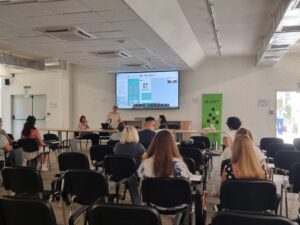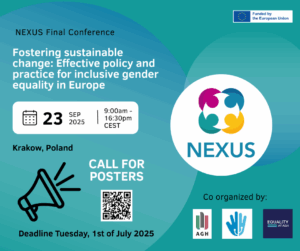👉 Full agenda: https://nexusproject.info/events-2/nexus-final-conference/

#NEXUSProject #FinalConference #GenderEquality #HigherEducation #EUResearch #EUScienceResearchandInnovation
👉 Full agenda: https://nexusproject.info/events-2/nexus-final-conference/

#NEXUSProject #FinalConference #GenderEquality #HigherEducation #EUResearch #EUScienceResearchandInnovation
We are excited to present the official video for the upcoming NEXUS Final Conference: “Fostering Sustainable Change: Effective Policy and Practice for Inclusive Gender Equality in Europe.”
📍 Kraków, Poland
🗓️ 23 September 2025
💻 Streamed online: https://www.youtube.com/@kssitwhagh
The video offers a first look at this landmark event, bringing together researchers, practitioners, and policymakers to explore how inclusive gender equality can be achieved across Europe.
👉 Watch the video and get ready to join us!
🔗 https://www.youtube.com/watch?v=vrRSSuyr_ZU
#NEXUSProject #FinalConference #GenderEquality #EUResearch #HigherEducation #EUScienceResearchandInnovation
📍 Kraków, Poland | 🗓️ 23 September 2025
💻 Streamed online: https://www.youtube.com/@kssitwhagh.
The NEXUS Final Conference “Fostering Sustainable Change: Effective Policy and Practice for Inclusive Gender Equality in Europe” will feature four engaging panel sessions:
🔹 Session 1 (10:45): Twinning initiatives for Inclusive Gender Equality – Benefits and Challenges
🔹 Session 2 (11:55): Inclusive gender equality in EU widening and associated countries: opportunities, barriers and ways forward
🔹 Session 3 (14:15): Communities of Practice for Inclusive Gender Equality in RPOs – what works?
🔹 Session 4 (15:25): Policy gaps, developments and recommendations
📲 Join us in Kraków or tune in online to engage with leading voices on inclusive gender equality in research and academia.
👉 Full agenda: https://nexusproject.info/events-2/nexus-final-conference/
#NEXUSProject #GenderEquality #HigherEducation #InclusivePolicy #EUResearch #FinalConference #EUScienceResearchandInnovation
Next week, the NEXUS consortium will gather in Krakow for the project’s International Final Conference “Fostering sustainable change: Effective policy and practice for inclusive gender equality in Europe”.
One of the highlights will be the presentation of the Policy Brief “Advancing Inclusive Gender Equality Plans: Policy Insights from the NEXUS Project”, which brings together key findings, recommendations, and policy implications emerging from two years of collaborative work across Europe. Stay tuned on the Session 4: Policy gaps, developments, and recommendations!
The Policy Brief, developed by Istituto Italiano di Tecnologia, addresses systemic barriers to equality in research and innovation, showcases promising practices piloted in nine institutions, and provides concrete policy insights on how to design more inclusive, intersectional, and intersectoral Gender Equality Plans (GEPs).
We look forward to sharing our work and engaging in dialogue with policymakers, institutions, and stakeholders.
#GenderEquality #ResearchInnovation #NEXUSproject #PolicyBrief #HorizonEurope #IstitutoItalianodiTecnologia
🗓️ 3 October 2025 | 🕚 11:00–12:30 CEST | 📍 Online via Zoom
Advancing Intersectional Equity in Higher Education: Fostering Access and Success for Romani Students
Join us for an insightful session exploring good and promising practices for the intersectional inclusion of Romani students in Higher Education across Europe.
🎤 Guest Speakers:
– Natasa Markovska | Roma Education Fund Foundation
– Senada Sali | European Roma Rights Centre (ERRC)
– Nadja Greku | European Roma Institute for Arts and Culture
✨ Learning objectives:
– Understand the barriers to access and success in higher education for Roma
– Learn about the gender dimension of Romani participation in Higher Education
– Acquire practical insights on creating inclusive environments for Romani students, with a specific awareness of gendered dynamics, across different European contexts
Register here: https://lnkd.in/d44aevEB

We are delighted to share the final agenda for the NEXUS Project Final Conference, taking place on 23 September 2025 in Kraków, Poland, hosted by AGH University.

Venue: AGH
The Faculty of Humanities
The AGH University of Science and Technology
ul. Czarnowiejska 36
30-054 Kraków
Building C7
1st floor, conference opening and sessions, room 1.14; posters – 1.13
Agenda
https://nexusproject.info/wp-content/uploads/2025/09/NEXUS-Final-Conference-23.09.2025.pdf
The NEXUS Project was presented at the T4EU-ERA T Summer School for Refugee, Displaced and At-risk Researchers, held at Sofia University, Bulgaria, from 1–6 September 2025.
The event provided a valuable platform to highlight the project’s mission of fostering inclusive gender equality in research and academia, while engaging with researchers navigating global challenges.
#NEXUSproject #GenderEquality #HigherEducation #EUResearch #T4EU #SofiaUniversity #EUScienceResearchandInnovation


🕒 Self-paced learning — Start anytime, move at your own rhythm!
🔗 Enroll now — https://lnkd.in/dn_5zbuf
Let’s amplify impact together!
👉 Smart Venice Technological University Dublin Frederick University Sofia University St. Kliment Ohridski Le Mans Université AGH University of Krakow Bay Zoltán Kutatóközpont Faculty of Mechanical Engineering University of Nis Istituto Italiano di Tecnologia Koç University – help us spread the word! 🌍💬
📌 The NEXUS Project – GA 101094949 – is funded by the European Commission under the Horizon Europe programme.

Discover the latest updates from the project, including highlights from recent events, progress on institutional transformation, and upcoming activities supporting inclusive gender equality in research and academia.
👉 Read the full issue here: Nexus Newsletter # 9 – July 2025
#NEXUSproject #GenderEquality #HigherEducation #EUResearch #InstitutionalChange #Newsletter #GEPs #HorizonEurope#ResearchExcellence #EUScienceResearchandInnovation hashtag
🖼️ New Abstract Submission Deadline: 1 August 2025
Great news! You still have time to share your work at the NEXUS Final Conference in Krakow, Poland on 23 September 2025!
We are extending the poster abstract submission deadline to 1 August 2025 to give more researchers, practitioners, and project teams the opportunity to present their insights and innovative practices for inclusive gender equality in research and academia.
🎯 Selected posters will be showcased at the conference:
Fostering Sustainable Change – Effective Policy and Practice for Inclusive Gender Equality in Europe
📲 Submit your abstract today – scan the QR code or register here:
🔗 https://lnkd.in/d_GiByWA
📚 More info: https://lnkd.in/dzZcKHUp

#ResearchExcellence #EUScienceResearchandInnovation #GenderEquality #NEXUSproject #CallForPosters